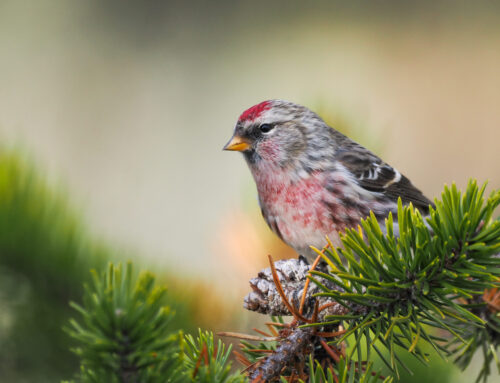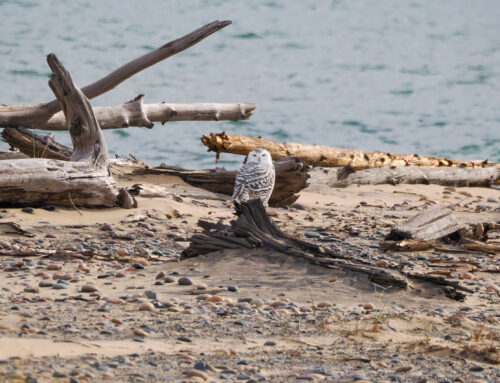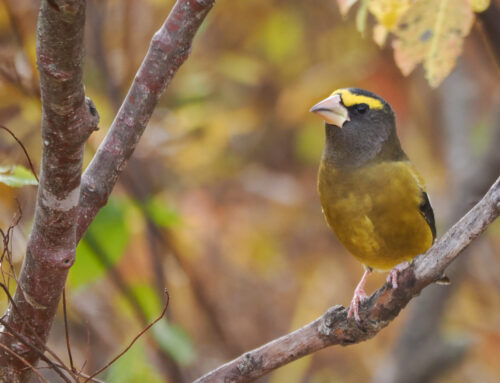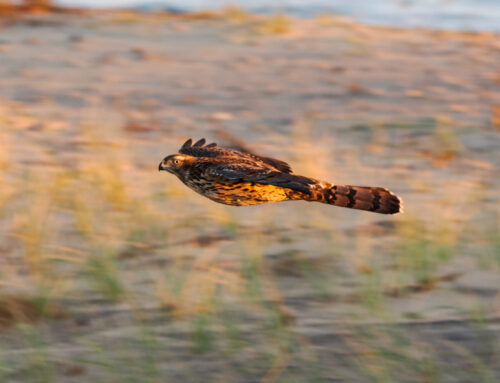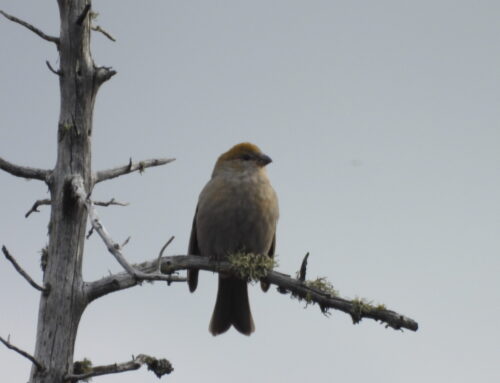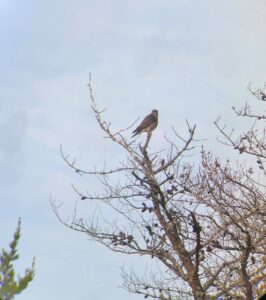
Merlin sitting in the tree line. Photo by Stephanie Owens
On Sunday, I walked onto the beach with hope and excitement. I wasn’t sure if the eggs would hatch that day, but I knew that they would come sometime soon. Almost as if a bad omen, a Merlin sat perched at the tree line, one I had not seen for the past two weeks. I shook off its oppressive presence and looked at the nest through my spotting scope. For the past two days the parents have been incubating with their bodies positioned slightly more above the eggs than usual, I suspected due to the chicks gradually pipping through their shells. I watched as Little Bill Bob and Vie switched turns and saw that the eggs were still intact. I walked towards the east to check on the bachelors, and once I returned, I noticed a strange figure peeking out from beneath Vie. Over time, I discerned that it was the head of a chick and watched as she tucked it back beneath her. During this time, Bob sat on the ledge of the sand, peeping strongly and persistently. Perhaps an arbitrary detail, but Wybie also sat at the ledge, barely moving for three hours.
I spent the rest of the day camped out at the nest, waiting to see the chicks take their first steps. But with the wind at around 15 mph and the temperature in the mid-50s all day, this would not happen, as it was far too cold for the chicks to emerge from beneath their parents.
My wishes were fulfilled the next day as I counted three chicks up and about. One egg still had not hatched. The parents seemed too caught up in tending to their active young to continue incubating, only doing so infrequently throughout the day for a few minutes.
On Tuesday, I checked the last egg for signs of pipping, and once it was determined to have been compromised, I was instructed to collect it for research.
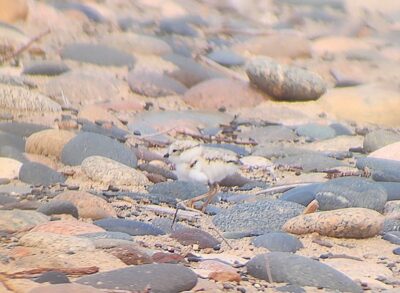
Piping Plover chick known as “Hop” hopping around. Photo by Stephanie Owens
I was greeted that morning by two chicks foraging at the water. I found the third chick farther away from its siblings and discovered something was wrong with its left leg or foot. He could not put any weight on it and was forced to hop around on his right leg. His balance was completely thrown off. I watched as he hopped a few times, fell over, rested, and got back up. This little bird became dear to me, and I started calling him Hop. Throughout the day, I watched him repeat his process of hopping and falling over. Sometimes, when he was resting, a parent would sit on him for protection and warmth, and the other two chicks would join Hop beneath.
Wednesday began as the day before, with two chicks at the shore accompanied by Vie. Hop was further inland, being sat upon by Bob. He and Vie spent all day on Hop, taking turns sitting on him as if he were an egg. As the day progressed, I became concerned and went to assess Hop’s condition. As I approached, Bob backed away, and I saw Hop lying weakly in a depression within the sand, barely moving his leg.
On Thursday, I was greeted by only one chick with Vie at the shore and found that Hop had passed over the night.
I spend my days now watching over the last chick, with its parents always close by. I cherish these times, as nature is unpredictable, and I hope this chick will survive and fledge.
~ Stephanie Owens
2024 Piping Plover Monitor
Featured photo: The last surviving chick with Little Bill Bob. Photo by Stephanie Owens
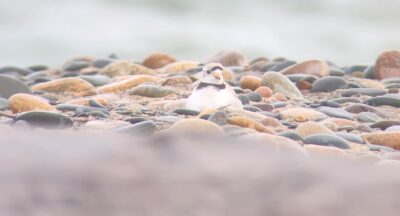
Little Bill Bob sitting on Hop. Photo by Stephanie Owens
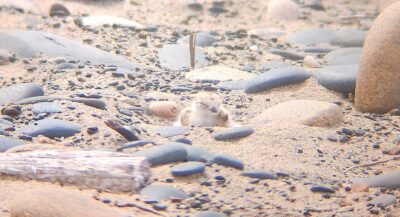
Piping Plover chick known as "Hop" resting. Photo by Stephanie Owens
Piping Plover monitoring is a collaborative effort between Michigan Audubon and Seney National Wildlife Refuge (USFWS).
You can keep up with the 2024 Piping Plover action at WPBO by reading Stephanie’s blog posts and following WPBO’s social media (Facebook, Instagram, and X).
Stephanie Owens: 2024 Piping Plover Monitor
 Stephanie is a native Yooper and a recent graduate of Lake Superior State University. She earned a Bachelor of Science in Conservation Biology and completed her senior thesis on the distribution of per- and polyfluoroalkyl substances in waterways in Eastern Upper Peninsula. Previously, she worked as a Piping Plover monitor in the U.P. for two seasons and conducted Black Tern and habitat surveys during that time as well.
Stephanie is a native Yooper and a recent graduate of Lake Superior State University. She earned a Bachelor of Science in Conservation Biology and completed her senior thesis on the distribution of per- and polyfluoroalkyl substances in waterways in Eastern Upper Peninsula. Previously, she worked as a Piping Plover monitor in the U.P. for two seasons and conducted Black Tern and habitat surveys during that time as well.


